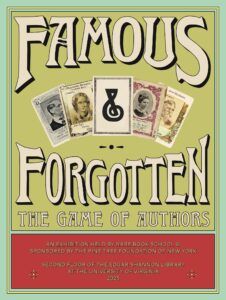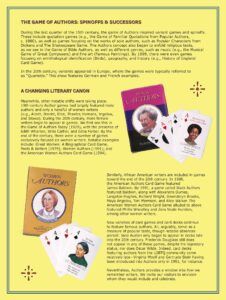Famous & Forgotten: The Game of Authors
Date:
19 May 2025 – 12 November 2025
Location: Held by Rare Book School on the second floor of the Edgar Shannon Library of the University of Virginia
Curated by: Barbara Heritage & Zoe Langer
An exhibition sponsored by the Pine Tree Foundation of New York. The exhibition opening will be held from 12-6:30 p.m. on Friday 12 September 2025 at Rare Book School. Click here for the detailed events schedule.
Fame isn’t forever. Will you be able to recognize some of the literary celebrities, famous in their day and now “forgotten” to most?
 Famous & Forgotten: The Game of Authors is an exhibition showcasing the card game of Authors, along with more than a dozen writers featured in its decks during the last 150 years. Installed in the second-floor gallery of UVA’s newly renovated Shannon Library, the show offers a perspective on changes in literary reputations, as well as the shifting tastes of readers: the east side of the gallery features authors who were famous during the nineteenth century and who remain household names to this day; the west side of the gallery tells the story of writers who were lauded during their lifetimes, but who are no longer recognized as literary celebrities.
Famous & Forgotten: The Game of Authors is an exhibition showcasing the card game of Authors, along with more than a dozen writers featured in its decks during the last 150 years. Installed in the second-floor gallery of UVA’s newly renovated Shannon Library, the show offers a perspective on changes in literary reputations, as well as the shifting tastes of readers: the east side of the gallery features authors who were famous during the nineteenth century and who remain household names to this day; the west side of the gallery tells the story of writers who were lauded during their lifetimes, but who are no longer recognized as literary celebrities.
Play the hand you’re dealt.
Originating in the United States in the mid-nineteenth century, Authors was created as a parlor game played by young women in Salem, Massachusetts, in 1861. The game is similar to Go Fish or Happy Families, but with a literary twist: players attempt to collect all cards pertaining to an author (e.g., “Charlotte Brontë,” “Jane Eyre,” “Shirley,” and “Villette”), making a “book” when doing so. To win, players memorize the names of authors and their works, and, in some cases famous quotations. Initially printed by Messrs Whipple & Smith in Massachusetts, the game proliferated and was later produced by McLoughlin Bros., Milton Bradley Company, Parker Brothers, Cincinnati Game Co., among others. Authors was frequently advertised as an “educational game,” with promotional materials aimed at families—particularly women and children. The game is still in production to this day, with variations and innovations highlighted in this show.
Fame. For some, they were the toast of the town in their day. But 100 years later, it wasn’t in the cards . . . literally.
 Dante. Shakespeare. Dickens. Brontë. Eliot. Twain. Baldwin. It will come as no surprise that these major literary figures appear in the game of Authors. These writers and their iconic portraits will be well known to most visitors. Charles Dickens, for instance, appears in every deck in RBS’s collection, which contains more than a hundred examples.
Dante. Shakespeare. Dickens. Brontë. Eliot. Twain. Baldwin. It will come as no surprise that these major literary figures appear in the game of Authors. These writers and their iconic portraits will be well known to most visitors. Charles Dickens, for instance, appears in every deck in RBS’s collection, which contains more than a hundred examples.
But many would be hard pressed to identify a work written by Robert Southey, who served as Britain’s Poet Laureate for three full decades (1813–1843). It is perhaps ironic that he advised Charlotte Brontë (then aged 20) that “Literature cannot be the business of a woman’s life & it ought not to be.” The German writer Luise Mühlbach was also an internationally renowned writer. Hailed during the nineteenth century for her historical romances, Mühlbach has been almost entirely forgotten by today’s readers. Similarly, most of our visitors probably have never read a work by Edward Bulwer-Lytton—though they may be familiar with the opening line, “It was a dark and stormy night,” which he authored in his 1830 novel, Paul Clifford.
It is sometimes said that “Life is like a game of cards.” But a game of cards can also influence life, helping shape the reputations of writers and the habits of readers. We invite you to browse these cases and consider the interplay of books, games, and the changing literary canon: how reading can be a form of play, and play a form of reading.
The Game of Authors: Spinoffs & Successors
During the last quarter of the 19th century, the game of Authors inspired variant games and spinoffs. These include quotation games (e.g., the Game of Familiar Quotations from Popular Authors, c. 1880), as well as games focusing on the works of sole authors, such as Popular Characters from Dickens and The Shakespeare Game. The Authors concept also began to enfold religious texts, as we see in the Game of Bible Authors, as well as different genres, such as music (e.g., the Musical Game of Great Composers) and fine art (Famous Paintings). By 1899, there were even games focusing on ornithological identification (Birds), geography, and history (e.g., History of England Card Game).
In the 20th century, variants appeared in Europe, where the games were typically referred to as “Quartetts.” This show features German and French examples.
A Changing Literary Canon
Meanwhile, other notable shifts were taking place. 19th-century Author games had largely featured male authors and only a handful of women writers (e.g., Alcott, Brontë, Eliot, Thaxter, Hemans, Ingelow, and Stowe). During the 20th century, more female writers begin to appear in games. We first see this in the Game of Authors Today (1929), with the presence of Edith Wharton, Willa Cather, and Edna Ferber. By the end of the century, there were a number of games exclusively focused on women writers. Notable examples include: Great Women: A Biographical Card Game, Poets & Writers (1979); Women Authors (1991); and the American Women Authors Card Game (1994).
Similarly, African American writers are included in games toward the end of the 20th century. In 1988, the American Authors Card Game featured James Baldwin. By 1991, a game called Black Authors featured Baldwin, along with Alexandre Dumas, Langston Hughes, Richard Wright, Gwendolyn Brooks, Maya Angelou, Toni Morrison, and Alice Walker. The American Women Authors Card Game alluded to above featured Phillis Wheatley and Zora Neale Hurston, among other women writers.
New varieties of card games and card decks continue to feature famous authors. All, arguably, serve as a measure of popular taste, though notable absences persist: Jane Austen only began to appear in decks late into the 20th century. Frederick Douglass still does not appear in any of these games, despite his legendary status, nor does Oscar Wilde. Indeed, card decks featuring authors from the LGBTQ community come relatively late—Virginia Woolf and Gertrude Stein having been introduced into Authors only in 1991, for instance.
Nevertheless, Authors provides a window into how we remember writers. We invite our visitors to envision whom they would include and celebrate.

